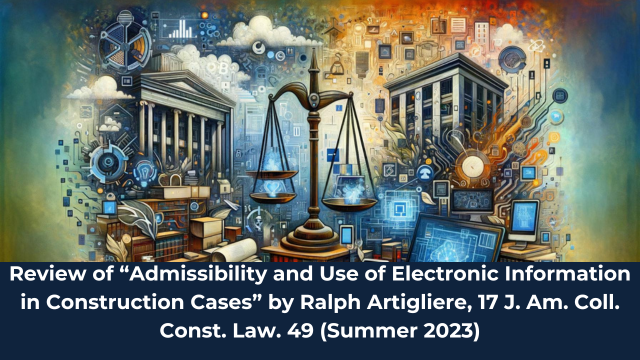
[Editor’s Note: EDRM is proud to publish the advocacy and analysis of Leslie King O’Neal. The opinions and positions are those of Leslie King O’Neal.]
In the past few years, new technologies have upended the way buildings are designed and built. These new technologies and the project information management software used with them create voluminous amounts of electronic data about all aspects of a project’s life, which can be valuable evidence in claims and disputes. But using such electronic information as evidence requires construction lawyers to authenticate it under the applicable evidence rules. This article is the first to focus specifically on admissibility of electronically stored information (“ESI”) generated in the design and construction area.
ESI can be a gold mine of useful information in construction claims and disputes. However, the path between finding a “gold nugget” of information and getting that information into evidence can be perilous and twisting, with many obstacles and snares.
Leslie King O’Neil.
ESI can be a gold mine of useful information in construction claims and disputes. However, the path between finding a “gold nugget” of information and getting that information into evidence can be perilous and twisting, with many obstacles and snares. Ralph Artigliere, a former civil trial lawyer and state court judge, with extensive knowledge of trial presentation methods, evidence rules and the intricacies of ESI, provides construction lawyers with detailed and practical advice about smoothing the path to have construction ESI admitted as evidence.
The steps needed to collect and preserve ESI to ensure its authenticity, which is critical from the beginning of a case, are explained in depth. In addition, the steps for admitting ESI into evidence and the applicable evidence rules are carefully outlined. Alternative methods for authenticating ESI in construction cases and for introducing ESI as demonstrative exhibits are analyzed, giving the advocate useful tools. Completing the overview of evidentiary issues is a discussion of methods for managing common objections to ESI such as hearsay, the best evidence rule, and the rule of completeness.
This article is an invaluable resource for all construction lawyers when undertaking a new construction case and when preparing for an evidentiary hearing, trial, or arbitration. It should be required reading for all new construction lawyers and is a good refresher for experienced construction litigators.
Leslie King O’Neil.
In this article, Judge Artigliere provides guidance about authenticating specific types of ESI common in construction cases, including group collaboration tools, digital photos and digitally stored data and databases. There is also discussion of the dangers posed by “deepfakes” created with artificial intelligence and suggested steps to prevent their use as evidence.
The excellent appendix citing numerous cases and articles about ESI, artificial intelligence, and authenticating digital evidence is a special bonus. This article is an invaluable resource for all construction lawyers when undertaking a new construction case and when preparing for an evidentiary hearing, trial, or arbitration. It should be required reading for all new construction lawyers and is a good refresher for experienced construction litigators.


